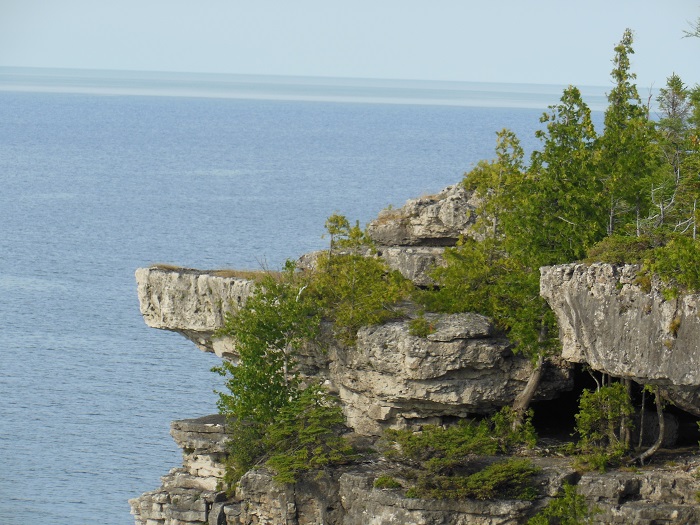[completed in 2016, 895 km, 25 days]
The clearest way into the Universe is through a forest wilderness. (John Muir)
There is a band of cliffs
that runs through Ontario
from Queenston Heights to Tobermory
that looks like a fault line between two tectonic plates.
It isn’t, though.
It’s an escarpment,
and it was created by the erosion of the softer shale
beneath a harder dolomitic limestone surface,
more obviously seen at Niagara Falls,
where the water has eroded the underlying shale
at a much faster rate than the surrounding area.
This prominent feature is called the
Niagara Escarpment.
And along the Niagara Escarpment lies a 900-kilometer path
called the Bruce Trail, Canada’s oldest
and longest-marked hiking trail.
The idea for the trail was conceived by Ray Lowes,
who shared it at a meeting of the Federation of Ontario Naturalists
with friend Robert Bateman in 1959.
From idea conception to completed path took only four years,
and on March 13, 1963, the Bruce Trail Association was incorporated.
I was four months old at the time
and I’m sure I already wanted to hike it.
The Bruce Trail is divided into nine sections (or clubs),
from the Niagara section in the south
to the Peninsula section in the north.
All are of varying lengths.
The Sydenham section is the longest at 168.4 kilometers
and the Toronto section is the shortest at 49.5 kilometers.
As a boy, my Dad would take us out to the trail once in a while
to explore the cracks and grottos of the escarpment.
They were a young explorer’s dream,
one which never left me all these years.
But a permanent move out of province as an adult,
work, family, and all that went with it
never gave me the month or so free time it would take
to hike this trail.
But a career break rekindled the dream,
and with trepidation, I posed for a photo
at the northern terminus of the Bruce Trail,
and stepped out alone onto the footpath in Tobermory.
For 25 days of hiking,
the white-blazed trail took me over rocky paths,
through peaceful forests,
up and down difficult hills,
around farmers’ fields,
through chest-high grass and weeds,
over boardwalks through mosquito-infested swamps,
down country lanes,
past Niagara vineyards,
through rainy days,
black fly clouds,
deer fly hordes,
and even through an Ontario heat wave.
Because the trail frequently ran along the top of the escarpment,
the views were fabulous.
And where there were no views,
there was the rock itself.
Always present was the rock of the escarpment,
weather-worn and beautiful in its shapes and configurations,
difficult at times to navigate,
soothing in its strength and familiarity.
The trail was quickly to become my friend,
but also my nemesis.
She would be easy on me at times
with her flat cushiony sections
that were ecstasy for sore feet,
and then she would punish my blistered feet
with a long section of boulder-strewn,
hilly wretchedness
that would leave me gasping
and my feet cringing with every step.
But I grew to love the Bruce Trail.
At times, I yelled at her in anger,
and other times, I would thank her
for taking me through such beautiful places.
She brought out the worst in me,
but also the best.












